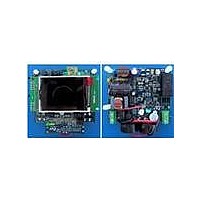STEVAL-IHP001V3 STMicroelectronics, STEVAL-IHP001V3 Datasheet - Page 28

STEVAL-IHP001V3
Manufacturer Part Number
STEVAL-IHP001V3
Description
BOARD SMART PLUG STM32 SPZB260PR
Manufacturer
STMicroelectronics
Series
Zigbee™ SmartPlugr
Type
Microcontroller, Energy Meteringr
Specifications of STEVAL-IHP001V3
Frequency
2.4GHz
For Use With/related Products
STM32F10x, SPZB260-PRO, STPM01
Lead Free Status / RoHS Status
Lead free / RoHS Compliant
Other names
497-10677
Theory of operation
8.13
8.14
Table 12.
28/60
KMOT (2 Bits)
Resetting the STPM01
The STPM01 has no reset pin. The device is automatically reset by the POR circuit when
the V
dedicated command (see SPI section for remote reset command details).
In case of reset caused by POR circuit all clocks and both DC buffers in the analog part are
kept off for about 30 ms and all blocks of digital part, except for SPI interface, which is hold
in a reset state for about 125 ms after a reset condition.
When the reset is performed through SPI no delayed turn on is generated.
Resetting the STPM01 causes all the functional modules of STPM01 to be cleared including
the OTP shadow latches (see paragraph 16 for OTP shadow latches description).
The reset through SPI (remote reset request) will normally take place during production
testing or in an application of meter with some on-board microprocessor when some
malfunction of metering device will be detected.
Energy to frequency conversion (standalone)
When used in standalone mode the STPM01 provides energy to frequency conversion both
for calibration and energy readout purposes. In fact one convenient way to verify the meter
calibration is to provide a pulse train signal with 50 % duty cycle whose frequency signal is
proportional to the active energy under steady load conditions. In this case the user will
choose a certain number of pulses on the LED pin that will corresponds to 1 kWh. We will
name this value as P.
The active energy frequency-based signal is available in the LED pin when APL = 2 or APL
= 3.
If APL = 2 the LED is driven from internal signal AW (active energy) whose frequency is
proportional to the active energy. The signal AW is taken from the 11
energy register, consequently a relationship between the LSB value of the active energy
register and the number of pulses provided per each kWh (P) can be defined as.
k
If APL = 3 the LED pin provides active energy frequency-based signal dependent on the
value of the KMOT configuration bit according to the following table. In this case the pulses
will have a fixed width of 31.25 ms.
Different settings for LED signal
Due to the innovative and proprietary power calculation algorithm the frequency signal is not
affected by any ripple at twice the line frequency, this feature strongly reduces the
calibration time of the meter.
AW
= 1000/(2
CC
0
1
2
3
crosses the 2.5 V value but it can be reset also through the SPI interface giving a
11
•P) [Wh]
Doc ID 10853 Rev 7
APL=2
Pulses
P
th
bit of the active
Pulses
APL=3
P/128
P/256
P/64
P/32
STPM01





















